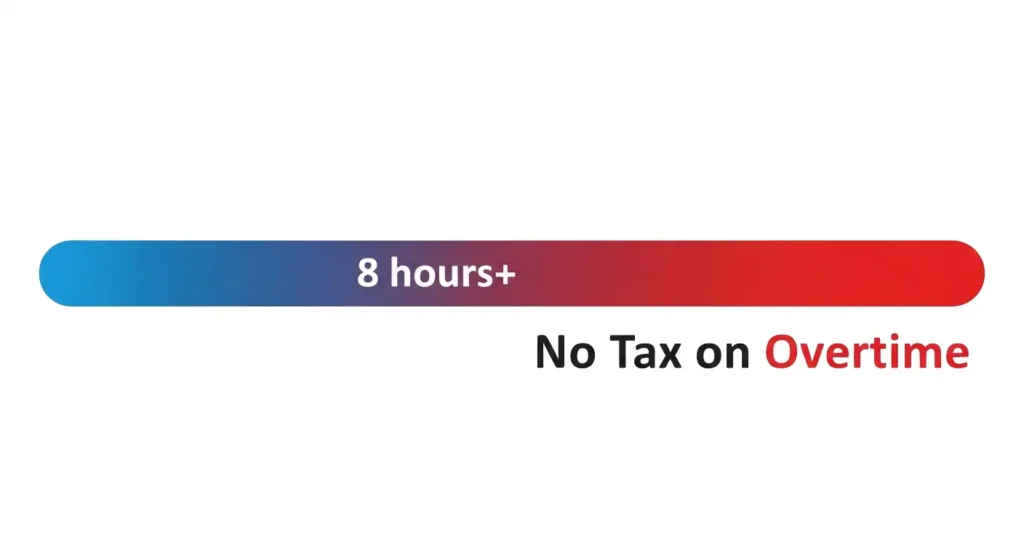
"No Tax on Overtime" Law 2025: A Quick Guide for Small Business Payroll & Compliance
The recently enacted "One Big Beautiful Bill Act" (OBBBA) has introduced sweeping changes to the U.S. tax code. For small businesses, one of the most talked-about components is the "No Tax on Overtime" provision. While presented as a straightforward benefit for workers, its implementation carries significant new compliance burdens and strategic considerations for employers. This article provides a comprehensive analysis to help your business navigate this new landscape.
In This Article
- TL;DR: Overview of the "One Big Beautiful Bill Act"
- Deconstructing the Overtime Tax Deduction: A Legal Deep Dive
- Implications for Employers: Compliance, Risks, and Strategy
- Impact on the American Worker and the Labor Market
- Fiscal Consequences and Macroeconomic Outlook
- A Spectrum of Stakeholder Perspectives
- Unresolved Questions and Future Outlook
- Streamline Your Payroll with TimeTrex
TL;DR: Overview of the "One Big Beautiful Bill Act"
On July 4, 2025, the "One Big Beautiful Bill Act" (OBBBA) was signed into law, fundamentally reshaping federal tax, spending, and security policy. Passed through the budget reconciliation process, the nearly 900-page bill was a landmark achievement for the administration's second-term agenda. Its passage was intensely partisan, highlighting the deep divisions in Congress.
The OBBBA is built on several core pillars:
- Tax Reform and Reduction: The bill's centerpiece is approximately $4.5 trillion in tax cuts, primarily making the 2017 TCJA cuts permanent and introducing new temporary breaks for tip income, auto loan interest, and overtime pay.
- Domestic Spending Reductions: To partially offset the tax cuts, the bill enacts over $1.2 trillion in spending reductions, heavily concentrated on programs like Medicaid and the Supplemental Nutrition Assistance Program (SNAP).
- Immigration and Security Funding: It allocates roughly $350 billion for national security and immigration enforcement, including funding for a border wall and expanded deportation operations.
Within this massive bill, the "No Tax on Overtime" provision was framed as a key pro-worker policy. Its inclusion serves a distinct legislative purpose, bundling a popular, easily messaged benefit with more contentious measures. This strategy, known as "logrolling," can obscure the full context of a provision, creating a public perception detached from its true fiscal and legislative reality.
Deconstructing the Overtime Tax Deduction: A Legal Deep Dive
Understanding the "No Tax on Overtime" provision requires a meticulous look at its legal mechanics, as its structure, scope, and limitations are highly specific.
The Mechanics of the Deduction
The provision is not a tax credit or a full exemption. It establishes a new above-the-line deduction from gross income for "qualified overtime compensation." This is a critical detail, as it allows eligible taxpayers to reduce their adjusted gross income (AGI) without needing to itemize, maximizing its potential reach. However, the deduction is temporary, applying only to tax years 2025 through 2028, and is subject to strict monetary and income caps.
| Feature | Specification |
|---|---|
| Provision Type | Above-the-line deduction from gross income |
| Effective Period | Tax Years 2025 through 2028 |
| Deduction Cap (Individual) | $12,500 per year |
| Deduction Cap (Married Filing Jointly) | $25,000 per year |
| Income Phase-Out (Individual) | Begins at Modified AGI of $150,000 |
| Income Phase-Out (Married Filing Jointly) | Begins at Modified AGI of $300,000 |
| Applicable Taxes | Federal Income Tax ONLY |
| Unaffected Taxes | FICA (Social Security & Medicare), State, and Local Taxes |
The Critical Definition of "Qualified Overtime Compensation"
Eligibility hinges on a precise legal definition: "overtime compensation paid to an individual required under section 7 of the Fair Labor Standards Act of 1938 that is in excess of the regular rate." This has two profound consequences:
- Only the Premium is Deductible: It is not a deduction on all earnings for hours worked beyond 40. In a standard "time-and-a-half" structure, only the "half" premium is deductible. For an employee earning $20/hour, the overtime rate is $30, but only the $10 premium is deductible.
- Federal Mandate is Key: The strict link to the federal FLSA excludes overtime paid for other reasons. This creates a complex web of exclusions, including overtime mandated by more generous state laws (like California's daily overtime) and premium pay negotiated in collective bargaining agreements (CBAs) that exceeds FLSA minimums.
This structure creates a "deduction cliff," where the benefit a worker receives depends on the specific legal authority mandating their overtime pay, not just their hours worked.
Implications for Employers: Compliance, Risks, and Strategy
While aimed at employees, the deduction imposes significant new burdens and strategic choices on employers.
New Compliance and Reporting Mandates
The law's most direct impact is a new reporting requirement. Employers must now separately track and report "qualified overtime compensation" on an employee's annual Form W-2. This is a novel mandate that will require significant updates to payroll systems, as they typically don't distinguish between different types of overtime pay. As detailed by payroll experts at RSM US, this represents a substantial, unfunded cost transferred to the private sector.
The law provides transitional relief for 2025, allowing a "reasonable method" for approximation, but this creates uncertainty until the Treasury Department issues formal guidance.
Legal Risks and Anti-Abuse Provisions
The new deduction introduces legal risks. The primary concern is the potential for abusive reclassification schemes, where an employer might artificially lower a base rate and reclassify regular pay as "overtime." Legal firms like Littler Mendelson warn employers to "exercise extreme caution" before changing compensation structures. The law directs the Treasury to issue anti-abuse regulations, signaling that the IRS will be scrutinizing pay structures for such schemes.
Strategic Human Resources Considerations
Despite the burdens, the deduction can be a potent recruitment and retention tool. In industries where overtime is common (manufacturing, logistics, healthcare), employers can market the increased take-home pay to attract hourly workers. However, this requires clear communication from HR departments to manage employee expectations, explaining the complex limits and clarifying why some workers may not receive the full benefit they anticipate from headlines.
Impact on the American Worker and the Labor Market
The deduction's ultimate effect is contested. While it offers potential for increased pay, the benefit is more modest and narrowly targeted than political rhetoric suggests.
Projected Financial Benefits and Their Limitations
Non-partisan analyses paint a modest picture. The Tax Policy Center projects that only about 2% of U.S. households will benefit, with an average tax cut of around $1,800 per year for those households. A key limitation is that the benefit is skewed away from the lowest-income workers, many of whom already have zero federal income tax liability. The primary beneficiaries are middle-income hourly workers who have a tax liability but don't exceed the income phase-out thresholds.
| Line Item | Scenario 1: No Overtime Deduction | Scenario 2: With Overtime Deduction |
|---|---|---|
| Annual Wages at Base Pay Rate | $30,000 | $30,000 |
| Annual Overtime Wages | $5,000 | $5,000 |
| Adjusted Gross Income (AGI) | $35,000 | $35,000 |
| Standard Deduction (Single Filer) | $16,000 | $16,000 |
| Overtime Deduction | $0 | $5,000 |
| Taxable Income | $19,000 | $14,000 |
| Federal Income Tax Liability (Approx.) | $2,042 | $1,442 |
| Annual Tax Savings | $600 | |
The Excluded Workforce: A Critical Caveat
A frequently overlooked aspect is the large segment of the workforce statutorily excluded from the benefit. The reliance on the FLSA means many iconic "blue-collar" professions are ineligible:
- Truck Drivers: Most truck drivers are exempt from FLSA overtime rules and, as the Owner-Operator Independent Drivers Association (OOIDA) points out, will not benefit.
- Railroad Workers: Members of rail unions like the BLET and Teamsters are covered by the Railway Labor Act (RLA), not the FLSA, and are therefore excluded.
- Other Exempt Professions: Many executive, administrative, professional, and sales employees, as well as teachers and clergy, are also exempt from FLSA overtime and receive no benefit.
Fiscal Consequences and Macroeconomic Outlook
The provision carries a substantial cost and contributes to the bill's overall impact on the national debt.
Estimated Impact on Federal Revenue
Non-partisan bodies project a significant revenue loss. The Joint Committee on Taxation (JCT) estimated a reduction of $90 billion through FY2029, while the Congressional Budget Office (CBO) projected a higher cost of $124 billion through the 2028 tax year.
Contribution to the National Debt
The CBO estimates the full OBBBA package will add between $3.3 trillion and $4.1 trillion to the national debt over the next decade. The temporary nature of the overtime deduction is a key feature with long-term implications. It creates a "fiscal cliff," where workers face an automatic tax increase in 2029 unless a future Congress extends the policy. This structure reduces the official 10-year cost but institutionalizes a high-stakes political battle for the future.
A Spectrum of Stakeholder Perspectives
The provision has generated a wide spectrum of reactions, revealing deep ideological divides.
| Stakeholder | Core Argument/Position |
|---|---|
| White House / Proponents | A fulfillment of a campaign promise to reward hard work and provide direct financial relief to middle- and working-class families. |
| AFL-CIO / SEIU | A "gimmick" or "distraction" within a bill that is overwhelmingly harmful to workers due to massive cuts in healthcare and social programs. |
| Teamsters / BLET / OOIDA | The provision is fundamentally flawed because its technical language (reliance on FLSA) excludes their members, who are among the most iconic "blue-collar" workers. |
| Business / Legal Community | A potential recruitment tool but creates significant new compliance burdens and legal risks related to reporting and reclassification. |
| Economic Think Tanks | A modest benefit for a narrow group that risks distorting the labor market by incentivizing overwork and potentially suppressing base wages. |
Unresolved Questions and Future Outlook
The passage of the OBBBA marks the beginning, not the end, of a complex implementation process. Critical details remain undefined, placing a heavy burden on the Treasury Department and the IRS to provide clarity. The most immediate challenge is the implementation of the new W-2 reporting requirements. Until the Treasury specifies what constitutes a "reasonable method" for 2025, employers and payroll providers are in a state of legal limbo.
Beyond these hurdles, the provision's future is defined by its 2028 sunset date. The temporary nature of the tax cut ensures it will become a central issue in future election cycles. In conclusion, the "No Tax on Overtime" provision is a multifaceted policy whose populist appeal belies its legal and economic complexity. It delivers a modest, temporary tax reduction to a narrow slice of the workforce while imposing significant new compliance burdens on businesses. Its ultimate legacy will depend on forthcoming regulatory guidance and the political battles fought over its extension.
Navigate Payroll Changes with Confidence
The "No Tax on Overtime" provision adds another layer of complexity to payroll management. TimeTrex's comprehensive payroll solutions are designed to adapt to new regulations, ensuring your business stays compliant and your employees are paid accurately. Let us handle the complexity so you can focus on what you do best.
Learn More About TimeTrex PayrollDisclaimer: The content provided on this webpage is for informational purposes only and is not intended to be a substitute for professional advice. While we strive to ensure the accuracy and timeliness of the information presented here, the details may change over time or vary in different jurisdictions. Therefore, we do not guarantee the completeness, reliability, or absolute accuracy of this information. The information on this page should not be used as a basis for making legal, financial, or any other key decisions. We strongly advise consulting with a qualified professional or expert in the relevant field for specific advice, guidance, or services. By using this webpage, you acknowledge that the information is offered “as is” and that we are not liable for any errors, omissions, or inaccuracies in the content, nor for any actions taken based on the information provided. We shall not be held liable for any direct, indirect, incidental, consequential, or punitive damages arising out of your access to, use of, or reliance on any content on this page.
About The Author

Roger Wood
With a Baccalaureate of Science and advanced studies in business, Roger has successfully managed businesses across five continents. His extensive global experience and strategic insights contribute significantly to the success of TimeTrex. His expertise and dedication ensure we deliver top-notch solutions to our clients around the world.
Time To Clock-In
Start your 30-day free trial!
Experience the Ultimate Workforce Solution and Revolutionize Your Business Today
- Eliminate Errors
- Simple & Easy To Use
- Real-time Reporting

Saving businesses time and money through better workforce management since 2003.
Copyright © 2025 TimeTrex. All Rights Reserved.
